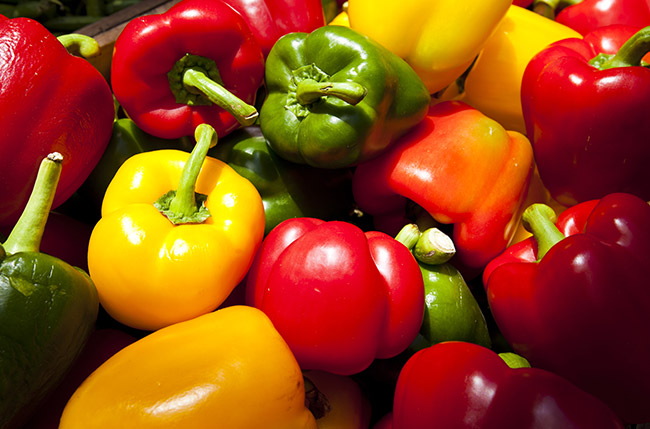
The bell pepper is a member of the plant species Capsicum annuum, the same species as other peppers like jalapenos and habaneros. Unlike their spicy relatives, bell peppers are completely mild. They produce no capsaicin, the chemical which gives peppers their heat. The bell pepper does not even register on the Scoville scale. The pepper has a sweet flavor and a crunchy texture, their flavor grows sweeter the more it is allowed to ripen on the plant. The peppers come in a variety of colors, such as red, yellow and green. These three colors of bell pepper are often sold together in packs called “traffic light packs.” They also come in orange, purple, white and rainbow, which is a pepper that is between stages of ripeness, making it multiple colors. Generally, the red variety of bell pepper is the fully ripened green pepper, but there are varieties of bell pepper that stay permanently green when fully ripe. Red peppers, since they are generally the most ripe of bell peppers, are usually the sweetest. Green peppers are somewhat bitterer than other varieties. Orange and yellow peppers are more similar in sweetness to red ones. Bell peppers are filled with hard, bitter seeds and white, cotton-like membranes that should be removed before using the pepper. Bell peppers, and the Capsicum annuum species of plant are native to the Americas and were first introduced to Europe after the Columbus voyages. Since then, peppers have become immensely popular, and have becomes staples in cuisines throughout the world, especially in Hungary, India and Africa. Bell peppers are also hugely popular in Mexico and Southwestern United States.
With their sweet flavor and hearty crunch, bell peppers work well as a topping for things like pizza, burgers and tossed salads. They are also often roasted first before being used as a topping, adding a bit of smokiness and sweetness, and softening the crunch of the pepper. Bell peppers are a key ingredient in Philly cheesesteaks and fajitas. When the bell pepper is thinly sliced and grilled or sautéed, it becomes very succulent and it becomes sweeter. Cooking the pepper brings out a lot of its flavor and gives it a wonderful, juicy texture, making it the ideal component in fajitas and Philly cheesesteaks. A common use of bell peppers is stuffing them and roasting them. They can be stuffed with almost anything, including cheese, meat, rice and other vegetables. They can be used as a variant on chiles rellenos, which is made by stuffing a pepper with cheese and meat, and then breaded and fried. These are usually made with Poblano or Anaheim chiles, but bell peppers can be used as a milder alternative.
Fresh bell peppers have smooth, shiny skin, and are firm and springy to the touch. They should be kept in the refrigerator in a plastic bag, and will stay fresh for just over a week. When the skin of the pepper becomes wrinkly, and the pepper is soft and soggy to the touch, it is no longer fresh and should not be used. To keep bell peppers much longer, slice them thinly, or chop them and freeze them. Frozen bell peppers will last indefinitely, but are best used within a year of freezing. When preparing a bell pepper, begin by removing the stem by cutting off the cap of the pepper. Then, to easily remove the majority of the seeds, reach in the pepper and grab the mass of seeds and membranes and pull it out. Slice off any remaining white membranes from the flesh of the pepper, and wipe off any remaining seeds. Note that bell peppers can sometimes have smaller peppers growing inside of them. This looks strange and surprising, but it is not a problem. If there is a little pepper growing inside of a bell pepper, simply pull it out and discard it. The bell pepper itself is still perfectly usable.


 BACK TO PRODUCTS
BACK TO PRODUCTS